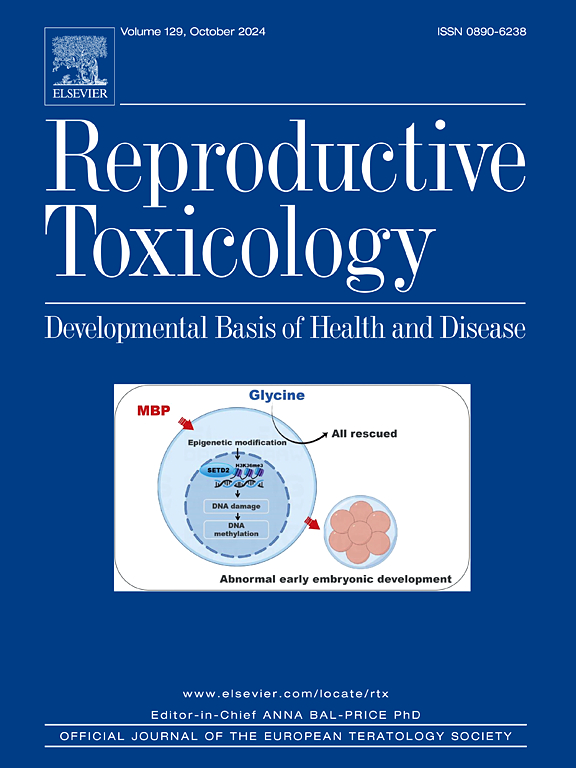Single- and combined-heavy metals/metalloids exposures are associated with infertility in US women aged 20–44: NHANES 2013–2020 analysis
IF 3.3
4区 医学
Q2 REPRODUCTIVE BIOLOGY
引用次数: 0
Abstract
Infertility is a major medical and social issue, with environmental factors, including metal exposure, playing a crucial role. This study analyzes how individual metals and their mixtures, which include a selection of heavy metals and metalloids totaling sixteen metals, contribute to infertility risk, using data from the National Health and Nutrition Examination Surveys. The study included 1326 women aged 20–44 years, comprising 1145 classified as fertile and 181 as infertile, with data on reproductive questionnaires and covariates. Infertility was defined through self-reported data. To assess the associations between exposure to these elements and infertility risk, we employed logistic regression, principal component analysis (PCA), restricted cubic splines (RCS), quantile regression with group-specific combination (qgcomp), and bayesian kernel machine regression (BKMR). After adjusting for potential confounders, logistic regression revealed positive associations of blood manganese (BMn) and urinary tin (USn) with infertility, whereas serum selenium (SSe) was negatively associated. RCS analysis demonstrated nonlinear relationships between urinary barium (UBa), urinary molybdenum (UMo), and urinary antimony (USb) and infertility. Potential interactions were identified between the following metal pairs: UMo and urinary cadmium, USb and UBa, and USb and UMo. PCA identified a positive association between PC3 and infertility (OR = 1.17, 95 % CI: 1.00, 1.36). The qgcomp model also indicated a positive association between metal mixtures and female infertility (OR = 1.25, 95 % CI: 1.03, 1.52). In conclusion, this study highlights significant associations between exposure to specific metals and infertility risk among women of reproductive age.
NHANES 2013-2020分析:美国20-44岁女性单一和组合重金属/类金属暴露与不孕症相关
不孕症是一个重大的医疗和社会问题,环境因素,包括金属接触,起着至关重要的作用。本研究利用国家健康和营养检查调查的数据,分析了单个金属及其混合物(包括精选的重金属和类金属,共计16种金属)如何导致不孕风险。该研究包括1326名年龄在20至44岁之间的女性,其中1145人被归类为可生育,181人被归类为不育,数据来自生殖问卷和协变量。不孕症是通过自我报告的数据来定义的。为了评估暴露于这些元素与不孕风险之间的关系,我们采用了逻辑回归、主成分分析(PCA)、限制三次样条(RCS)、群体特异性组合分位数回归(qgcomp)和贝叶斯核机回归(BKMR)。在调整潜在混杂因素后,logistic回归显示血锰(BMn)和尿锡(USn)与不孕症呈正相关,而血清硒(SSe)呈负相关。RCS分析显示尿钡(UBa)、尿钼(UMo)和尿锑(USb)与不孕症之间存在非线性关系。确定了以下金属对之间的潜在相互作用:UMo和尿镉,USb和UBa,以及USb和UMo。PCA鉴定PC3与不孕症呈正相关(OR = 1.17, 95% CI: 1.00, 1.36)。qgcomp模型也显示金属混合物与女性不育呈正相关(OR = 1.25, 95% CI: 1.03, 1.52)。总之,本研究强调了暴露于特定金属与育龄妇女不孕风险之间的显著关联。
本文章由计算机程序翻译,如有差异,请以英文原文为准。
求助全文
约1分钟内获得全文
求助全文
来源期刊

Reproductive toxicology
生物-毒理学
CiteScore
6.50
自引率
3.00%
发文量
131
审稿时长
45 days
期刊介绍:
Drawing from a large number of disciplines, Reproductive Toxicology publishes timely, original research on the influence of chemical and physical agents on reproduction. Written by and for obstetricians, pediatricians, embryologists, teratologists, geneticists, toxicologists, andrologists, and others interested in detecting potential reproductive hazards, the journal is a forum for communication among researchers and practitioners. Articles focus on the application of in vitro, animal and clinical research to the practice of clinical medicine.
All aspects of reproduction are within the scope of Reproductive Toxicology, including the formation and maturation of male and female gametes, sexual function, the events surrounding the fusion of gametes and the development of the fertilized ovum, nourishment and transport of the conceptus within the genital tract, implantation, embryogenesis, intrauterine growth, placentation and placental function, parturition, lactation and neonatal survival. Adverse reproductive effects in males will be considered as significant as adverse effects occurring in females. To provide a balanced presentation of approaches, equal emphasis will be given to clinical and animal or in vitro work. Typical end points that will be studied by contributors include infertility, sexual dysfunction, spontaneous abortion, malformations, abnormal histogenesis, stillbirth, intrauterine growth retardation, prematurity, behavioral abnormalities, and perinatal mortality.
 求助内容:
求助内容: 应助结果提醒方式:
应助结果提醒方式:


